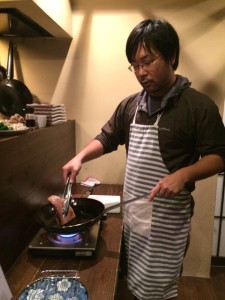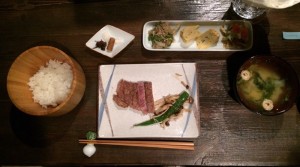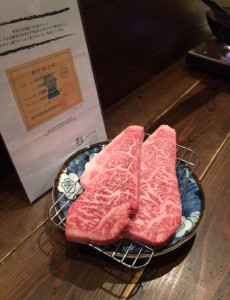(Resurrecting a post that’s been sitting in the Drafts folder for almost 2 years now, and testing a new crossposting plugin at the same time.)
We are not social people. Well, okay, we’re selectively social. We have our groups of friends that we see now and then, but we don’t generally seek out new acquaintances. This will become important in a bit.
But we do like to cook. When looking for things to do on this trip, Stephanie found this cooking class that covers several Japanese dishes, and includes a main dish of actual Kobe beef. We figured, “Sounds cool!” and signed up.
Each class has up to 6 people (not counting any kids under 6 that might be tagging along). But as we walked to the bus stop where we were to meet our host, we thought, “Maybe it’ll just be us two. We can pick this guy’s brain for techniques and what have you.” We get to the stop, and there are only a couple disinterested Japanese people waiting for the next bus. A few minutes later however, here comes a gaijin family – husband, wife, and two similarly-dressed daughters. They ask if we’re here for the cooking class, and we answer yes. Introductions are had, and the kind of forced, crappy small talk that usually happens between complete strangers commences. Fast forward another few minutes, and another gaijin couple approaches. Turns out they’re also in the class! More introductions, more small talk. This time we’re saved pretty quickly when our host, Taro, shows up to walk us to his house.
Ok, so I made these people out to be worse than they are. Really, everyone was pleasant and conversation wasn’t too hard to come by. Going down the roster, we had:
- Peter and Claire, with their daughters Chloe (6) and Mimi (4). Originally from the UK (Claire is actually Welsh, and was happy to hear we’d made that country a major part of our previous trip), they now live in Australia. We’d actually seen them at the Nishijin Textile Center earlier in the day.
- Jean-Baptiste (JB) and Hava, from Paris. JB had a camera, and took plenty of pictures.
Taro lead us the short walk to his house, which was a small but cozy and nicely decorated place just a couple minutes from the bus stop. Dark wood floors, bamboo across the ceiling stained to match, and just enough space to fit everyone. The adults donned slippers and aprons, while the children (including Taro’s 5-year-old daughter Haruko, for whom the class is named) plopped down in front of the TV with a Frozen DVD. More on that in a bit.
The class was fun and informative. Taro’s wife (whose name escapes me) did some of the prep, but the adult participants also did some slicing and other work. Later on Stephanie got to make Tamagoyaki in a rectangular pan. The whole time Taro was g iving us info on why things were done a certain way, how most Japanese people cooked at home, etc.
iving us info on why things were done a certain way, how most Japanese people cooked at home, etc.
And then there’s a lull in the conversation – “an angel passed”, for those who’ve read Neuromancer – and we hear the three girls off in the corner, singing “Let It Go”. It was an adorable moment.
For the Kobe itself, Taro did the cooking. His reasoning was it’s very easy to overcook, and he wanted to make sure we had the best experience possible. No one disagreed. Accompanying it were:
- rice

- miso soup
- some sort of mushroom-pepper stir fry (I think probably enoki and shishito)
- lotus root mixed with other veggies and sesame seeds
- the aforementioned tamagoyaki
- some other things I can’t recall and can’t quite identify from the pictures
After the meal the Aussies left rather quickly, I think to get their girls to bed. JB and Hava talked quite a bit about how Taro could market the class and get more business. Taro listened very politely.
We left about the same time as Hava and JB, but not before I asked Taro about something he’d used when cooking. It was a small, round squeeze bottle. The head was silicone, and had bristles like a basting brush. He’d used it to oil up the pans during the class. I said it was a clever idea, and he told how he tried to market them, but they didn’t take off. He did give us two of them, saying he had many left over, and we thanked him and left.
For those who are interested, here’s a closeup of the Kobe beef before cooking, and the certificate that proves it came from a Kobe-certified cow named Yuki.
(Note: if you think you ate Kobe beef in the US before 2012, you were lied to. There was no export of authentic Kobe until then. You ate Wagyu, which is the same breed, but Kobe beef is a certification/grade for beef that comes from the Kobe region and which has a certain fat percentage, etc. You might have eaten Kobe post-2012, but if you did you paid through the nose for it.)
Yuki was very tasty, although not the tastiest beef we had in Japan. The beef melted in the mouth and had pretty much no chew to it, just the essence of beef flavor. The best beef we had was a couple of days later, in Takayama, about which more later.
Crossposted all over the place. If you comment on Facebook or the DW feed we may not see them, but @ing telophase or myrialux via Twitter or commenting on the regular DW account, Flickr, and the actual blog should get to us. Or you could just email us@mushtee.com to be absolutely sure we get it.

